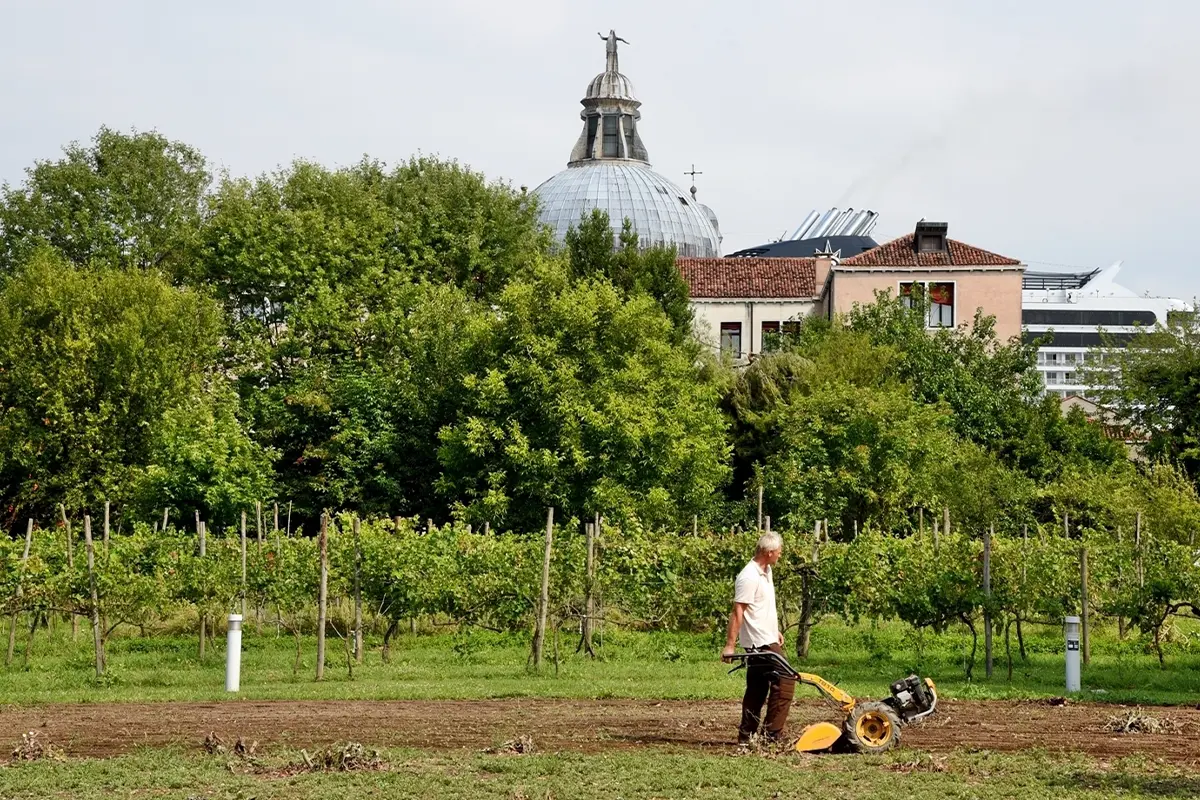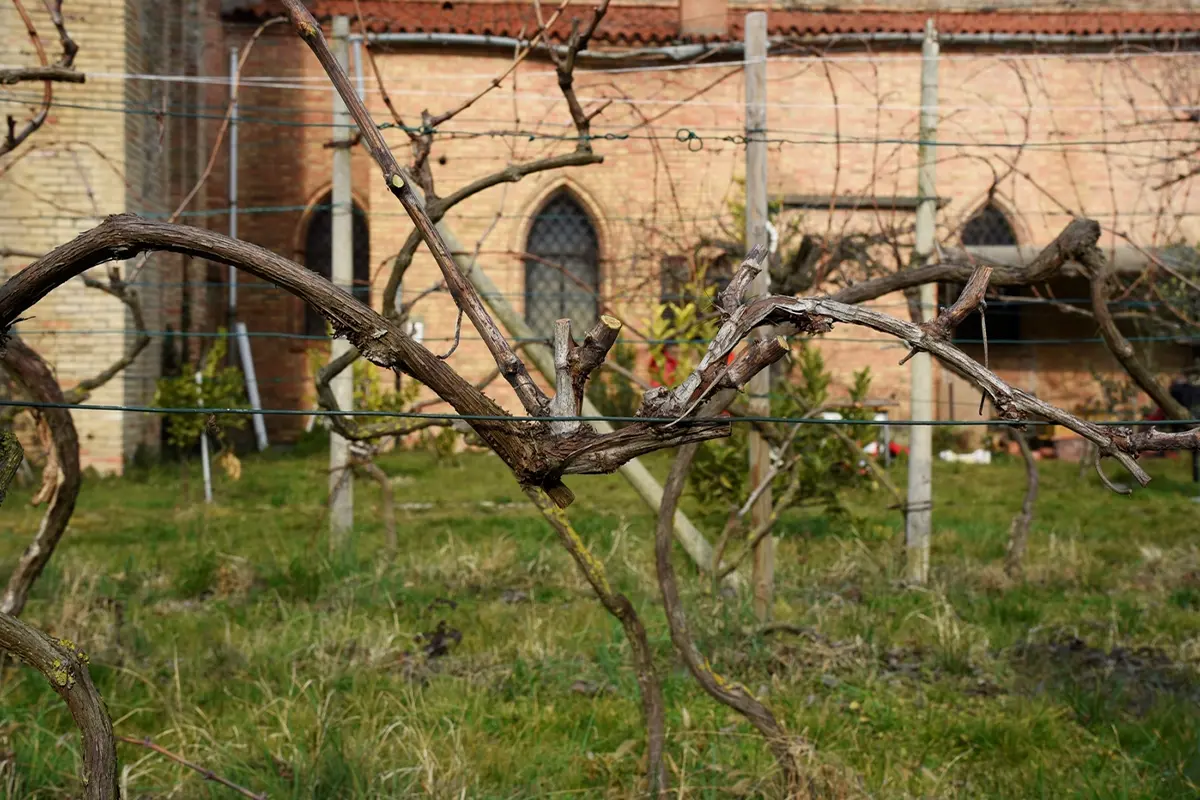The value of wine to Venetian history are be discerned in the city’s toponymy. Elements that define the vineyards of Venice include traditional architecture and indigenous vines
Reviving an ancient heritage
Vines have been grown on the Venetian Lagoon for centuries, with early records showing that there was once a vineyard in the Piazza San Marco. Over time, this agricultural tradition was lost. Areas of Venice were paved over in order to make room for living space and so this heritage has been overlooked within the historic records of the Venetian empire.
Yet there are still traces of this oenological history embedded within the fabric of the city, as in, for instance, the church of San Francesco della Vigna which derives its name from the fact that it was the site of a vineyard prior to its appropriation as the site for a Franciscan monastery in 1253. The value of wine to Venetian history can still be discerned in the city’s toponymy with examples such as ‘Calle della Malvasia’ , ‘Riva del Vin’ and the island of Le Vignole. In fact, wine is so embedded to Venice’s trading heritage that the term ‘un ombra’ derives from the fact that wines unloaded from ships were stored in the shade of the Campanile of San Marco.
La Laguna nel Bicchiere – Le Vigne Ritrovate
Vineyards are still dotted across the Venetian Lagoon, and in recent years there has been a revival of this heritage by various winemakers. Among these are Michel Thoulouze of Orto Venezia, Gianluca Bisol of Venissa and the initiative of La Laguna nel Bicchiere – Le Vigne Ritrovate founded by Flavio Franceschet. Collectively, they demonstrate that traditional vinification practices can be fused with new methods in order to face the challenges that climate change brings to the Lagoon.
This is particularly the case with La Laguna nel Bicchiere that is committed to reviving the ancient vineyards of Venice through in-depth research and sources grapes from sites where vines have traditionally been grown. These are often religious locations as it was Franciscan, Capuchin, Carmelite and Camaldolese convents and monasteries that were where these vines were grown including at Sant Elena, on San Michele in Isola where the vineyard is in the novices’ garden and at those near the Chiesa delle Zitelle on Giudecca that were first documented in the woodcut ‘View of Venice’ printed by Jacopo de’ Barbari in 1500.
A unique ecosystem and terroir
Producing wine on water is a feat that comes with its own peculiarities. The land of the Venetian lagoon is naturally saturated with seawater but yet this salinity does not necessarily have a negative impact on the possibility of crops flourishing in this locality. Instead, it is indicative of a unique ecosystem and terroir where a variety of factors are held in a delicate balance. This is particularly evident on the island of Sant’Erasmo that has been a haven for agriculture for centuries – with vineyards as early as the sixteenth century – partly on account of its unique soil composition and its slightly elevated position that provides some protection from the tidal flows. The land is parceled up into a number of small farms that produce a vibrant range of produce throughout the year that is mainly sold in Venice at the Rialto market or supplied to a co-operative of restaurants that includes Alle Testiere, Al Covo and Antiche Carampane.
It is not surprising, therefore, that when Thoulouze established his vineyard 29 years ago, he decided to purchase a plot of land on Sant’Erasmo. «It is the best soil on the Lagoon and I established my vineyard with one condition: to only make good wine». When planting new vines one of the first initiatives was to renovate the historic drainage systems of canals that collect rainwater and which are then drained into the lagoon through sluice gates at low tide. Further advantage is provided by the fact that even though the vineyard is situated «there is a brick reinforced bank that surrounds the land to stop the saltwater flooding in».
Vineyards not situated on the elevated land of Sant’Erasmo have adopted various other strategies to protect them from the specific climate of the Venetian Lagoon. On Mazzorbo the Dorona vines at Venissa are protected by high stone walls that block the prevailing winds; an approach consistent with that which was adopted on Giudecca five centuries ago. Historic evidence also shows that the marshy area was supported with poles constructed of chestnut wood. Other factors that are traditional to historic Venetian vineyards include the division of the plot into two adjacent partitions that are divided by a paved walkway to facilitate movement across the space.
Nurturing ancient vines back to health and productivity
The exceptionally high Aqcua Alta of 1966 destroyed much of Venice’s extant vineyards. The flood waters were so high that they submerged the land and the salinity of the sea water had an immediate impact on the vines’ health to the effect that many were simply abandoned. This has meant that prospective winemakers in recent decades have had to replant and introduce new varietals. In other instances, the goal has been to nurture these ancient vines back to health and productivity.
One of the varieties that has become most associated with Venetian wine is Dorona. Records show that these grapes have been grown on the Lagoon for centuries and in particular on the island of Sant’Erasmo. Following the flood of 1966, the cultivation of these vines went into decline and the rare variety was almost forgotten. In 2007, Gianluca Bisol spearheaded an initiative to cultivate this variety in a project based on the island of Mazzorbo known as Venissa.
It was the discovery of an unrecognized vine on the island of Torcello opposite the basilica of Santa Maria Assunta in 2002 that piqued Bisol’s curiosity and drive to stop this variety from being lost forever. Vines were planted on the site of a historic tenuta replete with a thirteenth century bell tower. The first harvest was done in 2010 with a production of 4880 bottles that are predominately in a 500ml format. The wines of Venissa are characterized for their salinity and the intensity of the grape which is emphasized through skin contact retting.
Soughting out endangered vines in the abandoned vineyards of Venice and encouraging their recultivation
Bisol is not the only winemaker to have engaged with this historic variety of Dorona or others that are specific to Venice. Franceschet of La Laguna nel Bicchiere has sought out endangered vines in the abandoned vineyards of Venice and encouraged their recultivation. For instance, on Vignole old vines of golden verduzzo – which is mainly grown in Friuli-Venezia-Giulia – were salvaged and cuttings of dorona, bianchetta and Malvasia were planted to replace dead vines.
Similarly on Giudecca in the vineyard near to the Chiesa delle Zitelle there are rows of Lambrusco Marani which has a heritage that can be traced to the wild vinegar vines cultivated in antiquity together with plantings of merlot, cabernet franc and Malvasia. Another peculiarity is the wine known as ‘Bacò della Strega’ that is produced from a hybrid red wine that grows in the center of Venice on the Pergola of the pizzeria Alla Strega in Castello.
Venetian climate – strong tolerance to early frosts and particularly windy sites
Over at Orto on Sant’Erasmo, Thoulouze decided 29 years ago to plant Malvasia Istriana and Vermentino. These he sourced from the Vivai Cooperativi Rauscedo (VCR) that consists of 30 hectares of trimmings of «almost every vine known that are stored in a long room like a library». Malvasia Istriana was chosen because it originates from the Istrian coast and therefore is suited to the soil of Venice. In fact, Malvasia has long been tied to the history of Venice: the Malvasia family of vines originates from Crete in Greece and was long imported to Venice during the Empire to the extent that wine shops in Venice were known as Malvasia during the Middle Ages.
Malvasia Istriana is particularly well suited to the Venetian climate as it has a strong tolerance to early frosts and particularly windy sites. In contrast, Vermentino is more traditionally associated with the coat of Liguria and is rarely used in the Veneto. The selection was based on an interest in balancing the characteristics of the two grapes. «Vermentino is an aromatic variety while Malvasia is more mineralic and therefore they produce a harmony». The proportions in which the two grapes are blended evolves with the vintage but in general it is 60% Malvasia to 40% Vermentino.
The harvests are becoming increasingly difficult
In the past few decades, Venice has faced a number of environmental issues as a result of climate change. Flavescenza Dorata in 2003 caused the decline of many vines and a widespread loss to biodiversity. The flood of 12 November 2019 caused a significant amount of damage to Venice’s fabric and also affected the land, with the excessive amount of saline water that submerged the land causing the damage to many vines. Recovery has sometimes been impossible. Instead, some vineyards have been abandoned and the possibility of replanting considered.
Despite these floods, Venetian winemakers are keen to emphasize that there is a major water issue. «There is a drought in Venice». recounts Thoulouze. «There has been hardly any rain for 2 years and so the harvests are becoming increasingly difficult». A similar point is recounted by Cesare Benelli of Al Covo who is a long term supporter of La Laguna nel Bicchiere who emphasizes «the vines need the rain desperately». The drought of Summer 2022 had a direct impact on the harvest with yields being significantly low. This will in turn feed through not only to the present vintage but also to future harvests due to the impact that the prolonged lack of water has on the health of the vines.




















